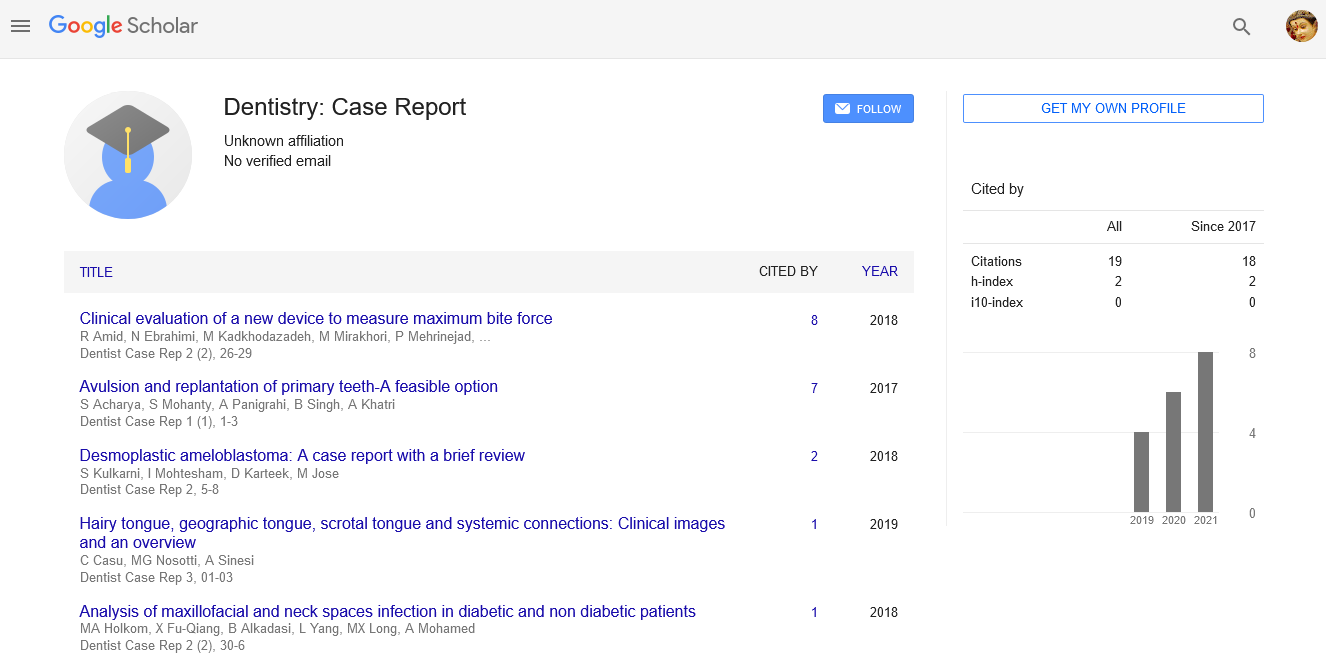Cosmetic dentistry and orofacial myology
Received: 11-Jan-2022, Manuscript No. puldcr-22-4658; Editor assigned: 13-Jan-2022, Pre QC No. puldcr-22-4658; Accepted Date: Jan 27, 2022; Reviewed: 20-Jan-2022 QC No. puldcr-22-4658; Revised: 24-Jan-2022, Manuscript No. puldcr-22-4658; Published: 27-Jan-2022, DOI: 10.37532. puldcr.22.6.1.1.
This open-access article is distributed under the terms of the Creative Commons Attribution Non-Commercial License (CC BY-NC) (http://creativecommons.org/licenses/by-nc/4.0/), which permits reuse, distribution and reproduction of the article, provided that the original work is properly cited and the reuse is restricted to noncommercial purposes. For commercial reuse, contact reprints@pulsus.com
Abstract
Cosmetic Dentistry improves the presence of an individual's teeth, gums and grin. It essentially centers around progress dental feel in shading, position, shape, size, arrangement and in general grin appearance. The medicines can be utilized to fix teeth brightening, full mouth recreation and grin makeover. Corrective medicines incorporate crowns, spans, fillings, dentures, dental inserts, holding, facade and tooth brightening.
Introduction
Facial Myology is a specialized professional discipline that evaluates and treats a variety of oral and facial (or facial) muscles, (mayor-) postural and functional disorders and oral habits that may disrupt normal dental development and also create cosmetic problems. The principals involved with the evaluation and treatment of or facial My functional disorders are based upon dental science tenets; however, or facial My functional therapy is not dental treatment. My functional therapy can be basically described as correcting an or-facial muscular unbalance, including correction of the position of the tongue at rest and during swallowing. Specific treatments involve establishing and stabilizing normal rest position of the tongue and lips, eliminating deviate (abnormal) oral habits and correcting swallowing patterns when tongue thrusting is involved. Improvements in appearance are observed during and following therapy.
Digital dentistry may be described in a far reaching expansion as any dental development or contraption that merges progressed or PC controlled parts rather than that of mechanical or electrical alone. This wide definition can reach out from the most consistently thought about districts of cutting edge dentistry-CAD/CAM (PC helped layout/PC upheld collecting) to those that may not be seen, for instance, PC controlled movement of nitrous oxide. Advanced Dentistry incorporates work in an assortment of zones including; CAD/CAM and intraoral imaging both research facility and clinician-controlled; Caries conclusion; Computer-helped embed dentistry- including plan and manufacture of careful aides; Digital radiography -intraoral and extraoral, including cone shaft registered tomography (CBCT); Electric and careful/embed hand pieces; Lasers; Occlusion and TMJ investigation and finding; Photography-extraoral and intraoral; Practice and patient record the board including computerized understanding instruction and Shade coordinating Dental pulp is the soft live tissue inside a tooth. Dental pulp contains stem cells, known as Dental Pulp Stem Cells. The finest Dental Pulp Stem Cells are found in a baby teeth or milk teeth. The stem cells from the milk teeth are 'mesenchymal' type of cells i.e. cells that have the ability to generate a wide variety of cell types like chondrocytes, osteoblasts and adipocytes. Chondrocytes are cells that have the ability to generate cartilage, which can play an important role in the treatment of arthritis and joint injuries. Osteoblasts are cells that have the ability to generate bones. Adipocytes are cells that have the ability to compose adipose tissue, specialized in storing energy as fat. In essence, dental stem cells can generate solid structures of the body such as bone, new dental tissue, cartilage and muscle. New research suggests the potential (currently under experimental research) to regenerate nerves. This is being studied further for use in dentistry and medicine.
Various studies have shown electronic dental gadgets may cause obstruction with embedded heart gadgets. More up to date heart gadgets are better protected and might be less powerless to obstruction Piezoelectric dental scalars might be more secure than magnetostrictive models. Electro surgery gadgets have the most noteworthy capability of electromagnetic obstruction. Legitimate use and separation are two significant variables influencing danger of impedance. Electronic dental instruments, as ultrasonic scalars or zenith locators, could possibly meddle with some implantable heart gadgets, for example, pacemakers or implantable cardioverterdefibrillators.
Cardiovascular implantable electronic gadgets (CIEDs) utilize electrical driving forces to keep up appropriate heart mood. They are winding up progressively basic as the underlying populace into which they were presented ages with an expanded future, and as implantations have increased. This implies patients, dental experts and staff are bound to have CIEDs, expanding the likelihood of electromagnetic obstruction from electronic dental gear.





